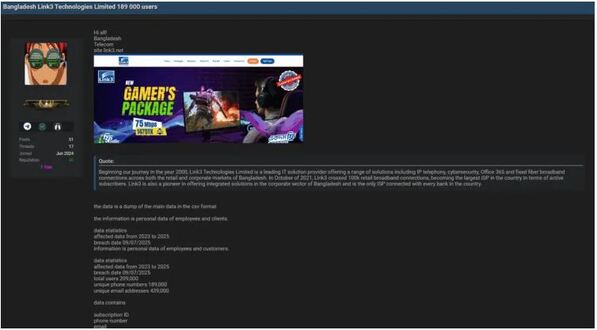The BlackByte ransomware group is suspected of using a recently fixed security issue in VMware ESXi hypervisors. They are also taking advantage of weak drivers to bypass security measures.
A vulnerability named CVE-2024-37085 lets attackers bypass authentication on VMware ESXi systems connected to an Active Directory domain.
By infosecbulletin
/ Wednesday , September 17 2025
A threat actor claims to have breached Link3, a major IT solutions and internet service provider based in Bangladesh. The...
Read More
By infosecbulletin
/ Wednesday , September 17 2025
Check point, a cyber security solutions provider hosts an event titled "securing the hyperconnected world in the AI era" at...
Read More
By infosecbulletin
/ Tuesday , September 16 2025
Cross-Site Scripting (XSS) is one of the oldest and most persistent vulnerabilities in modern applications. Despite being recognized for over...
Read More
By infosecbulletin
/ Monday , September 15 2025
Every day a lot of cyberattack happen around the world including ransomware, Malware attack, data breaches, website defacement and so...
Read More
By infosecbulletin
/ Monday , September 15 2025
A critical permission misconfiguration in the IBM QRadar Security Information and Event Management (SIEM) platform could allow local privileged users...
Read More
By infosecbulletin
/ Monday , September 15 2025
Australian banks are now using bots to combat scammers. These bots mimic potential victims to gather real-time information and drain...
Read More
By infosecbulletin
/ Saturday , September 13 2025
F5 plans to acquire CalypsoAI, which offers adaptive AI security solutions. CalypsoAI's technology will be added to F5's Application Delivery...
Read More
By infosecbulletin
/ Saturday , September 13 2025
The Villager framework, an AI-powered penetration testing tool, integrates Kali Linux tools with DeepSeek AI to automate cyber attack processes....
Read More
By infosecbulletin
/ Saturday , September 13 2025
Samsung released its monthly Android security updates, addressing a vulnerability exploited in zero-day attacks. CVE-2025-21043 (CVSS score: 8.8) is a...
Read More
By infosecbulletin
/ Saturday , September 13 2025
Albania has appointed the first AI-generated government minister to help eliminate corruption. Diella, the digital assistant meaning Sun, has been...
Read More
By using this flaw, the BlackByte operators can create a harmful “ESX Admins” group and add users to it, giving them full administrative privileges on the ESXi hypervisor.
Cisco Talos researchers found that BlackByte has been using this vulnerability in recent attacks. They noticed that the group keeps improving its use of vulnerable drivers to evade security measures and spread a ransomware encryptor that can self-propagate like a worm.
Free Webinar on Detecting & Blocking Supply Chain Attack -> Book your Spot
Exploit Chain:
Initial access is gained through valid VPN credentials, likely obtained via brute-force attacks.
The attackers escalate privileges by compromising Domain Admin accounts.
They create an “ESX Admins” Active Directory group and add malicious accounts to it.
This grants the attackers full administrative access to domain-joined ESXi hypervisors due to the CVE-2024-37085 vulnerability.
The BlackByte ransomware is then deployed, which uses a self-propagating mechanism to spread across the network.
The latest version of the BlackByte ransomware appends the “.blackbytent_h” extension to encrypted files. It also drops four vulnerable drivers as part of its Bring Your Own Vulnerable Driver (BYOVD) technique to bypass security controls:
RtCore64.sys (MSI Afterburner driver)
DBUtil_2_3.sys (Dell firmware update driver)
zamguard64.sys (Zemana Anti-Malware driver)
gdrv.sys (GIGABYTE driver)
click here to read out the full report.
 InfoSecBulletin Cybersecurity for mankind
InfoSecBulletin Cybersecurity for mankind














